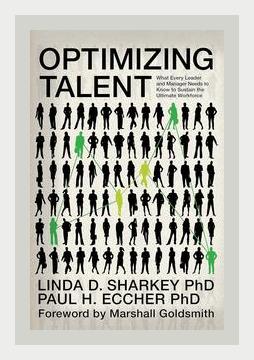Human Resources and Talent ManagementHR Technology
Introduction
“Optimizing Talent” by Linda Sharkey addresses crucial aspects of talent management through the lens of HR technology. The book delves into effective strategies for developing and maintaining a high-performing workforce, providing practical examples and actions that leaders and managers can implement.
Major Points and Actions
1. Strategic Talent Management
Point: Linda Sharkey emphasizes the importance of aligning talent management with organizational strategy.
Example: A company looking to expand its innovative capabilities should focus on recruiting and developing employees who excel in creative problem-solving and innovative thinking.
Action: Conduct strategic alignment sessions where HR leaders and business executives map out the talent requirements directly linked to business goals.
2. Building a Competency Framework
Point: Establishing a clear competency framework helps in identifying key skills and behaviors needed across the organization.
Example: An organization may identify competencies such as ‘teamwork,’ ‘adaptability,’ and ‘customer focus’ as critical.
Action: Develop a detailed competency matrix and roll it out through workshops, ensuring everyone understands the essential skills and behaviors.
3. Embracing HR Technology
Point: Utilizing advanced HR technology to streamline talent management processes.
Example: Implementing an HRIS (Human Resource Information System) can facilitate seamless integration of recruitment, training, performance management, and succession planning.
Action: Invest in a scalable HRIS and provide training sessions to ensure all HR personnel can utilize the system effectively.
4. Effective Recruitment and Onboarding
Point: Sharkey advocates for a strategic approach to recruitment and onboarding to attract and retain top talent.
Example: Integrating social media platforms with recruitment software to reach a wider talent pool.
Action: Develop an employer branding strategy and use HR technology to track and enhance the candidate experience from application to onboarding.
5. Continuous Learning and Development
Point: Promoting a culture of continuous learning is vital for maintaining a competitive edge.
Example: Implement an online learning portal with customized learning paths for employees based on their roles and career aspirations.
Action: Regularly update the learning content and encourage employees to engage with the platform by aligning learning goals with performance appraisals.
6. Performance Management
Point: Sharkey stresses the importance of regular and constructive performance evaluations.
Example: Using performance management software for real-time feedback and continuous performance tracking.
Action: Establish a routine for performance check-ins and utilize data analytics to provide actionable insights during evaluations.
7. Succession Planning
Point: Proactive succession planning ensures continuity and prepares the organization for future challenges.
Example: Identifying and grooming high-potential employees for leadership roles through targeted development programs.
Action: Develop a succession planning tool within the HRIS to track potential successors and monitor their progress.
8. Employee Engagement and Retention
Point: High employee engagement leads to better retention and organizational performance.
Example: Conducting regular engagement surveys and leveraging analytics to pinpoint areas of improvement.
Action: Implement action plans based on survey results, and introduce initiatives such as recognition programs and career development opportunities to boost engagement.
9. Diversity and Inclusion
Point: Building a diverse and inclusive workplace is essential for fostering innovation and competitiveness.
Example: Applying analytics to monitor and enhance diversity metrics within the organization.
Action: Create a diversity council and integrate diversity goals into the broader talent management strategy.
Notable Examples and Actions for Key Insights
Competency Mapping in a Financial Services Firm
Example: A financial services firm mapped competencies like analytical thinking and regulatory knowledge as crucial for roles in risk management.
Action: Develop competency-based interviews and assessments to ensure candidates possess these critical skills.
Social Media Integration for Recruitment
Example: A tech startup leveraged LinkedIn’s advanced search capabilities to identify and attract software engineers with niche skills.
Action: Create a dedicated social media recruitment team and train them on the latest social media tools and techniques.
Online Learning Portals at a Global Corporation
Example: A global corporation like IBM implemented an extensive online learning portal that offers courses in advanced technologies.
Action: Ensure continuous feedback from employees to keep the learning content relevant and aligned with industry trends.
Real-Time Feedback Systems in Retail
Example: A retail chain utilized a performance management tool to provide real-time feedback to store managers, significantly improving customer satisfaction scores.
Action: Pilot the feedback system in one department or location before a full rollout, allowing for adjustments based on initial results.
Succession Planning Tools in Healthcare
Example: A healthcare provider used succession planning software to identify and develop potential future leaders for key medical and administrative roles.
Action: Regularly review and update the succession plan, considering the dynamic nature of the healthcare industry.
Engagement Surveys in a Manufacturing Plant
Example: An automotive manufacturing plant conducted quarterly engagement surveys and addressed concerns swiftly, leading to reduced turnover rates.
Action: Develop a transparent communication strategy to share survey results and outline the steps the organization will take to address identified issues.
Diversity Metrics in a Tech Company
Example: A tech company used advanced analytics to track diversity metrics and implemented policies that supported underrepresented groups.
Action: Set specific, measurable diversity goals and review progress regularly during leadership meetings.
Conclusion
Optimizing Talent by Linda Sharkey provides a comprehensive roadmap for leaders and managers aiming to build and sustain a high-performing workforce. By integrating strategic talent management with HR technology, organizations can achieve greater alignment between their talent processes and business objectives. The actionable insights and real-world examples provided in the book serve as invaluable tools for any leader committed to optimizing their organization’s talent.
